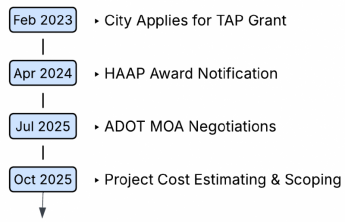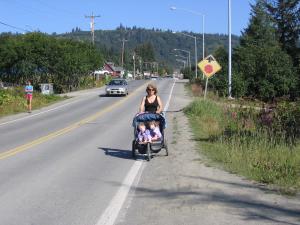-
About Homer
-
- Americans with Disabilities Act Compliance Program City Campgrounds Community Recreation Hickerson Memorial Cemetery
- Library Parks & Trails Public Safety Fire Police Emergency Information
- Events & Activities City Calendar Library Calendar Recreation Calendar Doing Business in Homer Sister City Program Coast Guard City
-
- Departments
- Government
- How Do I?
Homer All-Ages and Abilities Pathway
Project Description
Since adopting its first Non-Motorized Transportation Plan over 20 years ago, the City has made significant strides in addressing the lack of sidewalk facilities in Homer, a town originally designed around automobile transportation in the 1960s. However, critical sidewalk gaps remain in Homer’s Central Business District.
The Homer All-Ages and Abilities Pathway (HAAP) project designs and constructs missing sidewalk sections on both local and State of Alaska owned roads to complete two interconnected pedestrian loops in the Central Business District, creating safe, continuous routes that address safety hazards, improve mobility, and strengthen community connectivity and access to everyday destinations.
Scope
- 1,940 LF of sidewalk on Main Street between Pioneer Avenue and Bunnell Avenue.
- 1,060 LF of sidewalk on Svedlund between Pioneer Avenue and Fairview Avenue.
- Rectangular Rapid Flashing Beacons and high-visibility crosswalk pavement markings where Main Street and Svedlund Street sidewalk intersect Pioneer Avenue.
- 1,290 LF of sidewalk on Herndon Avenue and Lee Drive between Svedlund Street and Main Street.
- 680 LF of sidewalk on Bunnell Ave to connect with the Beluga Slough Trail System.
- Crosswalk on Bunnell Ave at Beluga Place.
- Rectangular Rapid Flashing Beacons and high-visibility crosswalk pavement markings on the Sterling Hwy at Hazel Avenue.
Phase
![]()

Cost Estimate
The total project cost estimate is currently being developed by by Alaska Department of Transportation and Public Facilities.
The completion of the cost estimate will determine the scope of the project that can be accomplished within the project's secured funding of $3,486,78.
Funding

Needs and Benefits
Safety: The proposed sidewalk connections improve safety for pedestrians currently sharing the road with up to 1,900 vehicles daily. Narrow shoulders and deep roadside ditches provide no safe separation from traffic or escape path to avoid collisions, and as Homer's population, tourist activity, and traffic counts have grown, residents report feeling less safe and comfortable walking and bicycling.
Between 2016 and 2021, 86% of crashes involving pedestrians and bicyclists in Homer occurred on roads without sidewalks. Since 2016, at least 17 pedestrians and bicyclists have been injured in the community, with three pedestrians hospitalized due to vehicle crashes between July 2021 and July 2022—more than double the national injury rate per capita. Two of these recent hospitalizations occurred at HAAP project locations.
Protecting Vulnerable Users: HAAP's ADA-compliant sidewalks and tactile curb ramps are essential for people experiencing disabilities or mobility impairments. Currently, the lack of accessible infrastructure forces individuals using mobility assistive devices to share the roadway with vehicle traffic—an unsafe and often impossible situation. HAAP improvements ensure equitable access to community destinations for people of all abilities. Transportation barriers are felt most acutely by individuals experiencing a disability.
According to the most recent US Census Bureau data, 13% of Homer’s noninstitutionalized population experiences a disability. For many, the option of operating a car is simply an impossibility. Completing sidewalk connections, ADA-compliant curb ramps and Rapid Flashing Beacons proposed for HAPP removes these barriers in the most heavily used areas of Homer’s central business district and reduces the distances needed to travel to reach destinations.
The Svedlund/Herndon and Lee Street sidewalks particularly benefit Homer's senior population, as this area serves Homer’s Senior Center and a concentration of senior housing complexes and connects residents to Pioneer Avenue businesses and services and Homer's Medical District. Seniors face heightened risks when navigating roads without pedestrian infrastructure. Pedestrians aged 65 and older are more than five times as likely to die in crashes as younger pedestrians, due to reduced agility, perception, and response time. Seniors also experience a higher incidence of pedestrian crashes at intersections, making HAAP's high-visibility crosswalks critical safety improvements.
Supporting Active Transportation: Safe non-motorized transportation options is a quality-of-life objective prioritized in Homer's Comprehensive Plan and Transportation Plan and contributes to positive individual health outcomes. By providing safe pedestrian access to essential community destinations—including retail businesses, restaurants, employment centers, health and social services, places of worship, educational institutions, and recreational facilities—HAAP supports active (human-powered) transportation. Homer is a community where people choose to walk: nearly 2,000 pedestrian trips are taken daily, and the share of people walking to work is more than double the national average (6.3% compared to 2.6% nationwide). HAAP fills critical sidewalk gaps in the most heavily traveled central business district areas to ensure residents and visitors can choose to safely walk to their destinations.



